Abstract
The present study was undertaken to investigate the mechanism whereby alpha adrenergic stimulation with intravenous norepinephrine results in a water diuresis. Renal perfusion pressure was kept constant in all experiments by adjustment of a suprarenal aortic clamp. In hydropenic anesthetized dogs the intravenous infusion of norepinephrine (0.5 μg/kg per min) was associated with a mean decrease in urinary osmolality from 616 to 126 mosmol/kg (P < 0.001) which increased to 532 mosmol/kg (P < 0.001) after the infusion was discontinued. During the same period of time the mean free water clearance increased from -0.437 to 1.59 (P < 0.001) and then returned to -0.314 ml/min (P < 0.001) after cessation of the infusion. This diuretic effect occurred in both innervated and denervated kidneys and was not associated with an increase in glomerular filtration rate or solute excretion. Systemic arterial pressure increased from 121 to 142 mm Hg during the norepinephrine infusion. Studies were also performed in hypophysectomized animals receiving a constant infusion of either 80 μg/kg per min or 20-40 μU/kg per min of vasopressin. In these animals, intravenous norepinephrine was not associated with changes in either urinary osmolality or free water clearance. The intrarenal administration of norepinephrine, in doses comparable with those reaching the kidneys during the intravenous studies, also resulted in no significant change in either urinary osmolality or free water clearance in hypophysectomized animals receiving 20-30 μU/kg per min of vasopressin. These results thus indicate that the water diuresis associated with intravenous norepinephrine is mediated primarily by suppression of vasopressin release rather than by changes in renal hemodynamics, renal innervation, or an effect of norepinephrine on the water permeability of the tubular epithelium.
Full text
PDF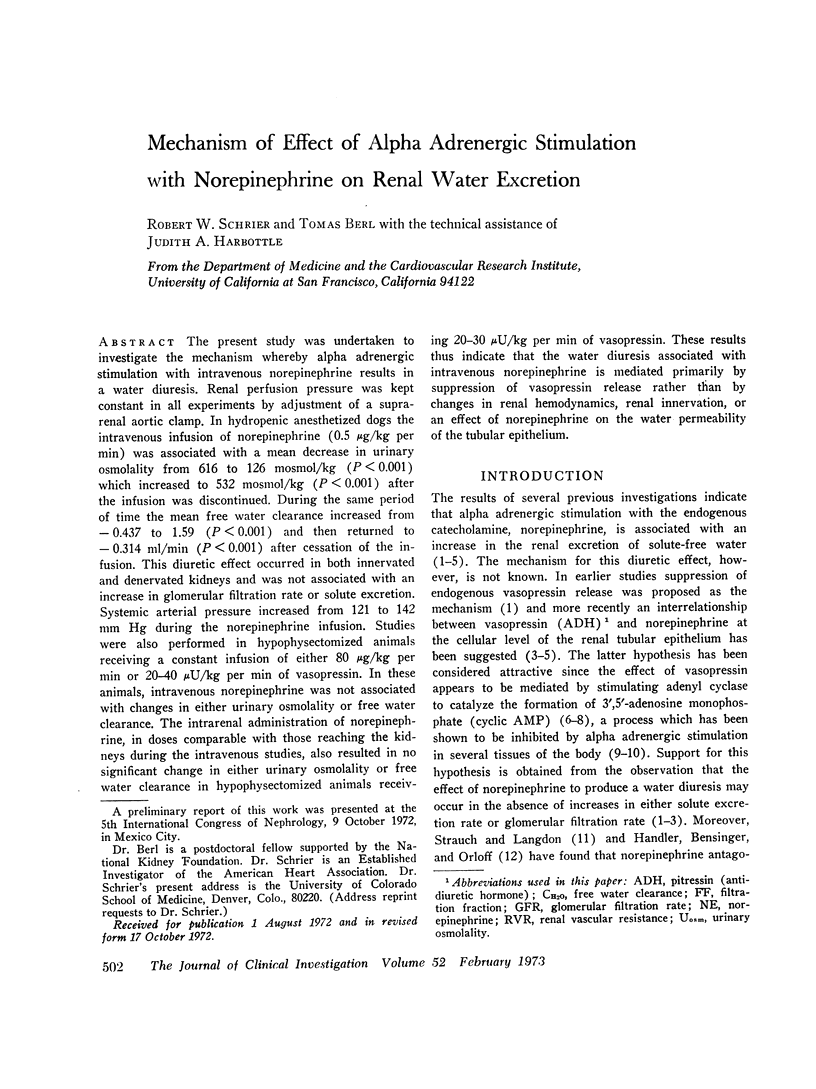
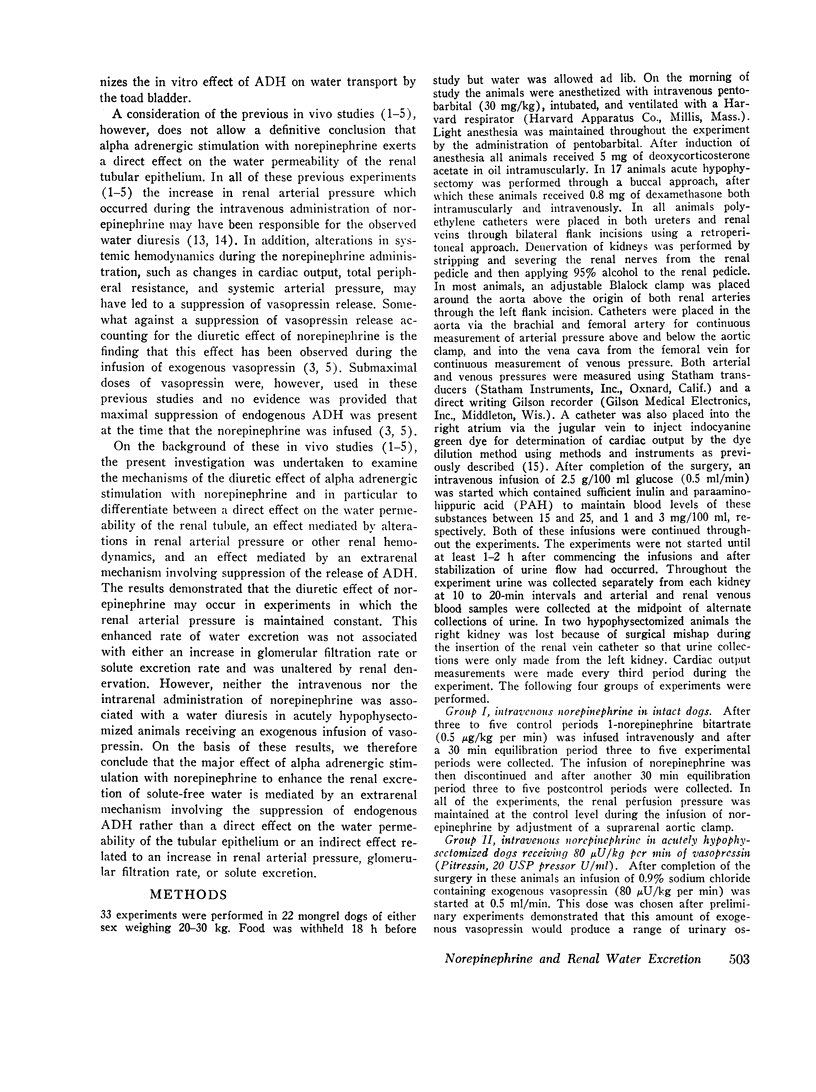
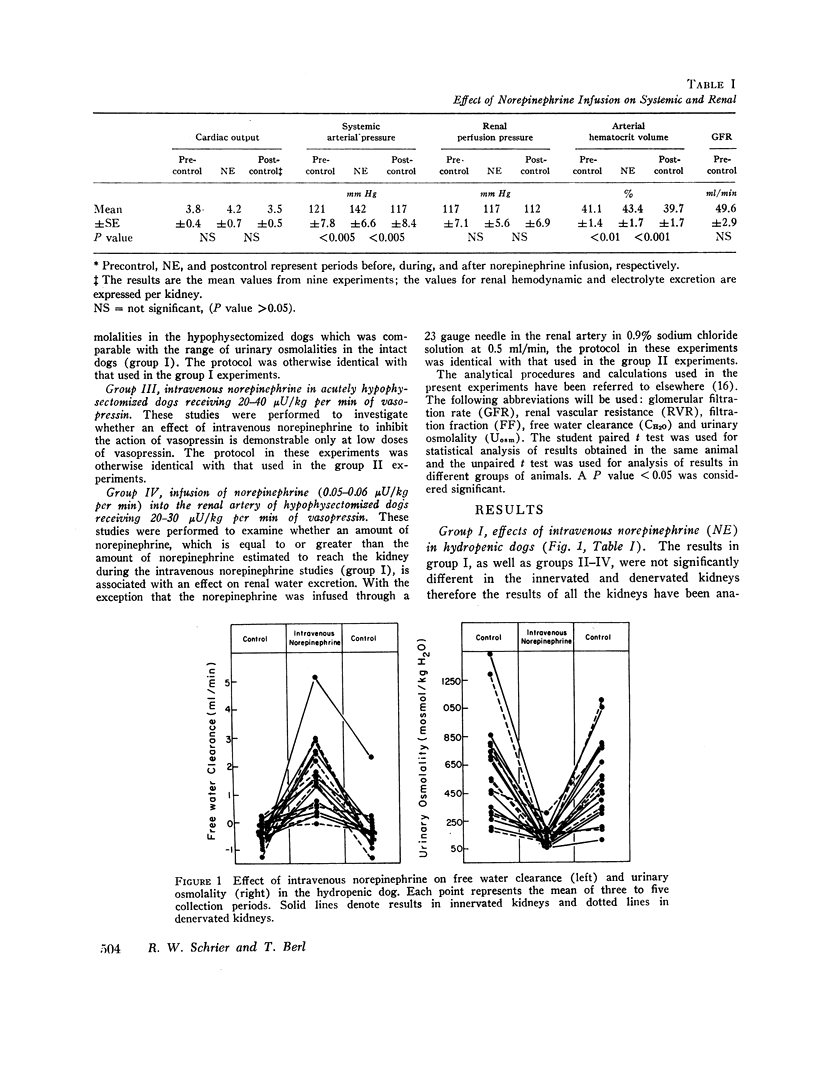
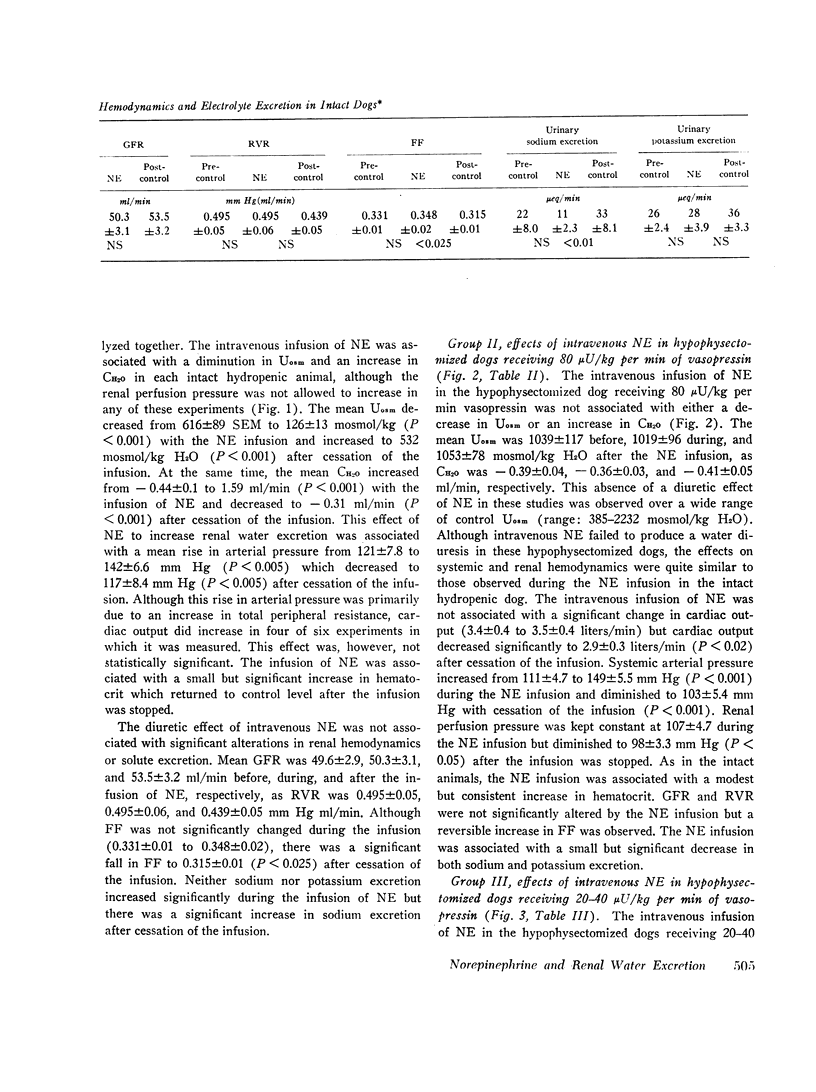
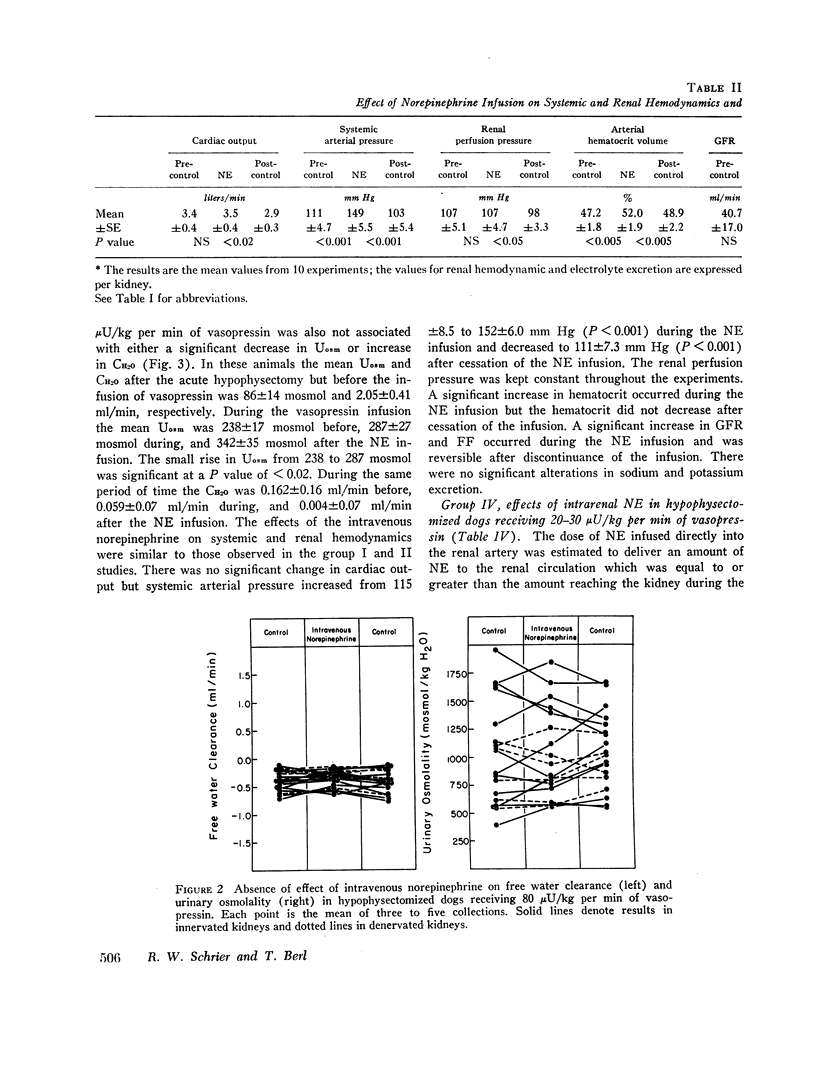
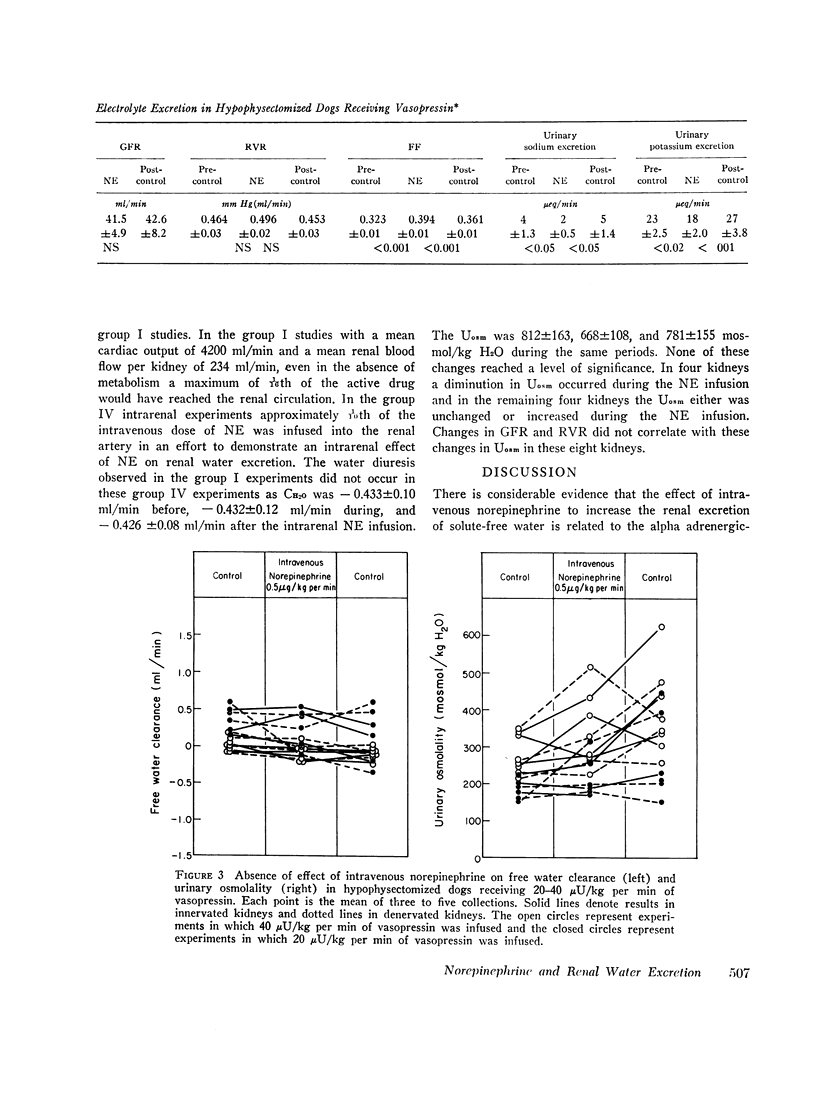
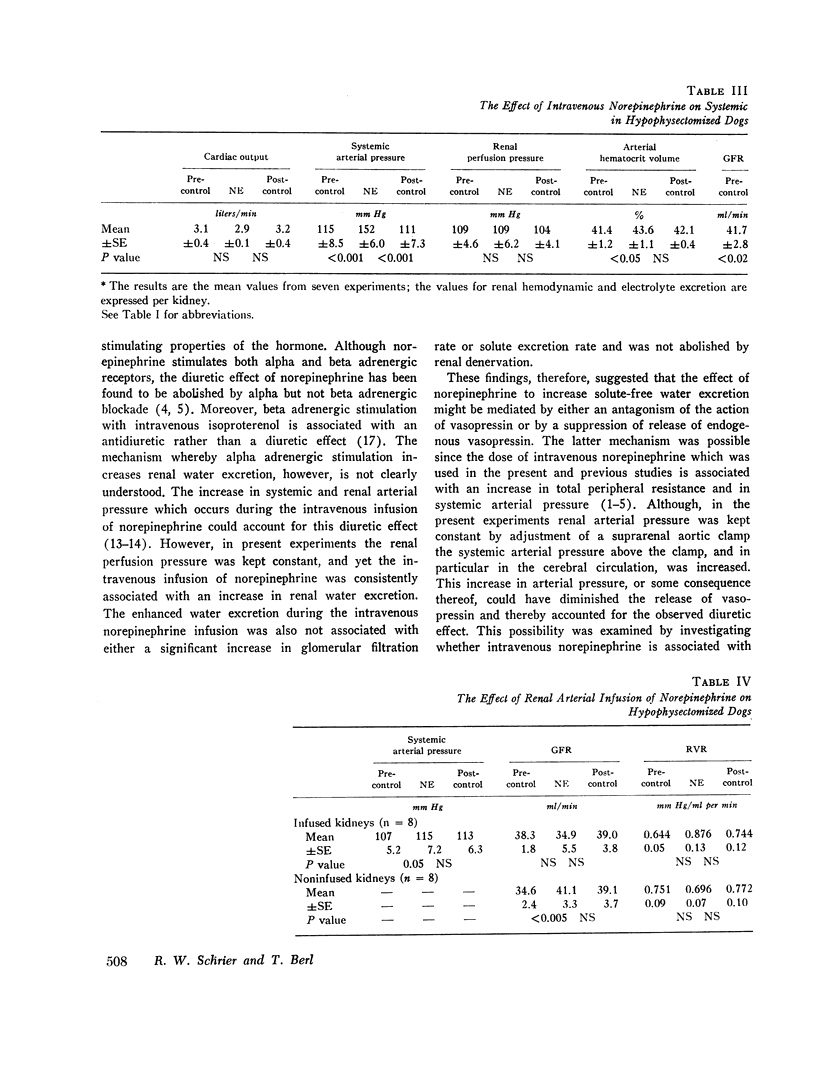
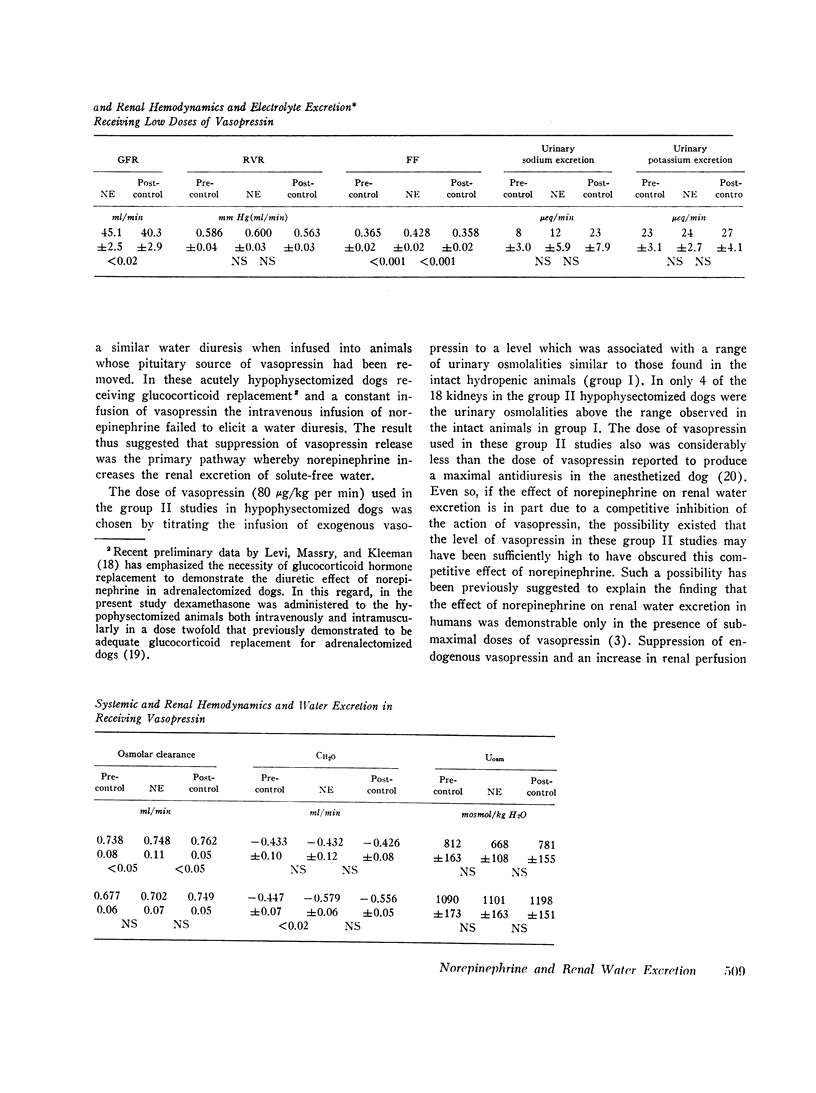
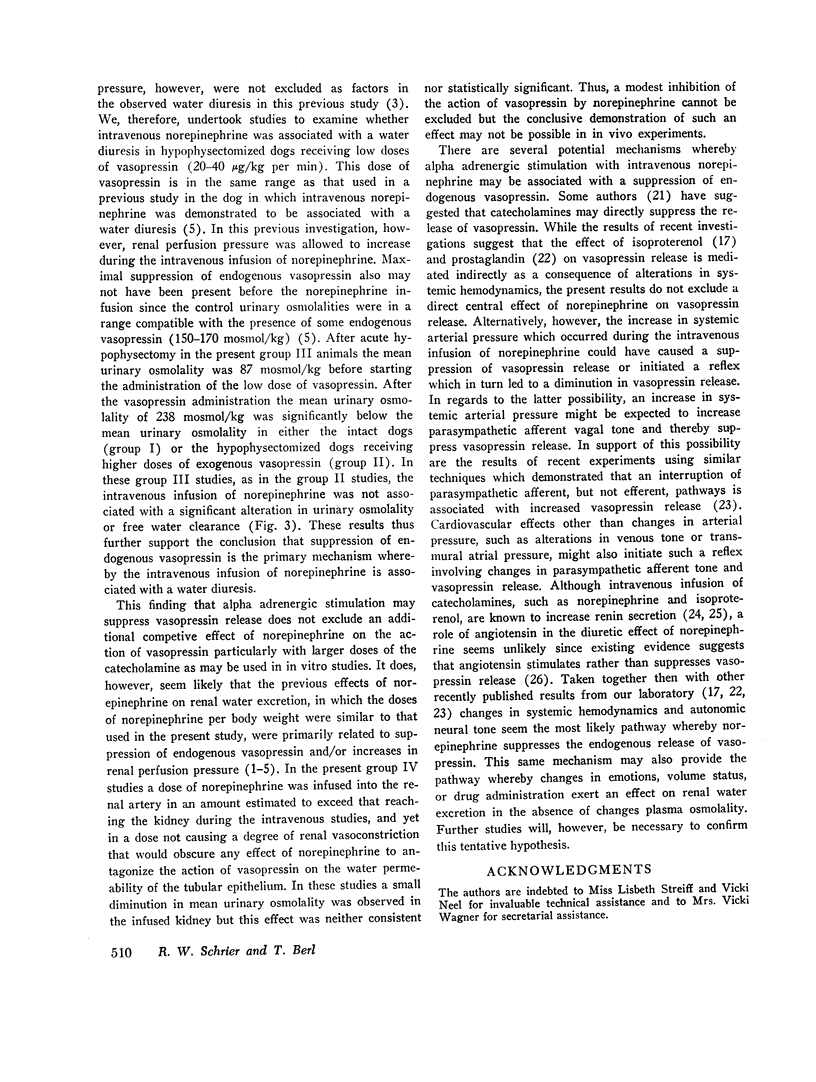

Selected References
These references are in PubMed. This may not be the complete list of references from this article.
- ABRAHAMS V. C., PICKFORD M. Observations on a central antagonism between adrenaline and acetylcholine. J Physiol. 1956 Mar 28;131(3):712–718. doi: 10.1113/jphysiol.1956.sp005496. [DOI] [PMC free article] [PubMed] [Google Scholar]
- BALDWIN D. S., GOMBOS E. A., CHASIS H. Changes in sodium and water excretion induced by epinephrine and I-norepinephrine in normotensive and hypertensive subjects. J Lab Clin Med. 1963 May;61:832–857. [PubMed] [Google Scholar]
- Berl T., Schrier R. W. Mechanism of effect of prostaglandin E 1 on renal water excretion. J Clin Invest. 1973 Feb;52(2):463–471. doi: 10.1172/JCI107203. [DOI] [PMC free article] [PubMed] [Google Scholar]
- Bonjour J. P., Malvin R. L. Stimulation of ADH release by the renin-angiotensin system. Am J Physiol. 1970 Jun;218(6):1555–1559. doi: 10.1152/ajplegacy.1970.218.6.1555. [DOI] [PubMed] [Google Scholar]
- Chase L. R., Aurbach G. D. Renal adenyl cyclase: anatomically separate sites for parathyroid hormone and vasopressin. Science. 1968 Feb 2;159(3814):545–547. doi: 10.1126/science.159.3814.545. [DOI] [PubMed] [Google Scholar]
- Fisher D. A. Norepinephrine inhibition of vasopressin antidiuresis. J Clin Invest. 1968 Mar;47(3):540–547. doi: 10.1172/JCI105750. [DOI] [PMC free article] [PubMed] [Google Scholar]
- Handler J. S., Bensinger R., Orloff J. Effect of adrenergic agents on toad bladder response to ADH, 3',5'-AMP, and theophylline. Am J Physiol. 1968 Nov;215(5):1024–1031. doi: 10.1152/ajplegacy.1968.215.5.1024. [DOI] [PubMed] [Google Scholar]
- Klein L. A., Liberman B., Laks M., Kleeman C. R. Interrelated effects of antidiuretic hormone and adrenergic drugs on water metabolism. Am J Physiol. 1971 Dec;221(6):1657–1665. doi: 10.1152/ajplegacy.1971.221.6.1657. [DOI] [PubMed] [Google Scholar]
- Liberman B., Klein L. A., Kleeman C. R. Effect of adrenergic blocking agents on the vasopressin inhibiting action of norepinephrine. Proc Soc Exp Biol Med. 1970 Jan;133(1):131–134. doi: 10.3181/00379727-133-34424. [DOI] [PubMed] [Google Scholar]
- Mason J. M., Ledsome J. R. The effects of changes in the rate of infusion of vasopressin in anesthetized dogs. Can J Physiol Pharmacol. 1971 Nov;49(11):933–940. doi: 10.1139/y71-130. [DOI] [PubMed] [Google Scholar]
- Orloff J., Handler J. The role of adenosine 3',5'-phosphate in the action of antidiuretic hormone. Am J Med. 1967 May;42(5):757–768. doi: 10.1016/0002-9343(67)90093-9. [DOI] [PubMed] [Google Scholar]
- Porte D., Jr A receptor mechanism for the inhibition of insulin release by epinephrine in man. J Clin Invest. 1967 Jan;46(1):86–94. doi: 10.1172/JCI105514. [DOI] [PMC free article] [PubMed] [Google Scholar]
- Reid I. A., Schrier R. W., Earley L. E. An effect of extrarenal beta adrenergic stimulation on the release of renin. J Clin Invest. 1972 Jul;51(7):1861–1869. doi: 10.1172/JCI106988. [DOI] [PMC free article] [PubMed] [Google Scholar]
- SELKURT E. E., WOMACK I., DAILEY W. N. MECHANISM OF NATRIURESIS AND DIURESIS DURING ELEVATED RENAL ARTERIAL PRESSURE. Am J Physiol. 1965 Jul;209:95–99. doi: 10.1152/ajplegacy.1965.209.1.95. [DOI] [PubMed] [Google Scholar]
- SMYTHE C. M., NICKEL J. F., BRADLEY S. E. The effect of epinephrine (USP), l-epinephrine, and l-norepinephrine on glomerular filtration rate, renal plasma flow, and the urinary excretion of sodium, potassium, and water in normal man. J Clin Invest. 1952 May;31(5):499–506. doi: 10.1172/JCI102634. [DOI] [PMC free article] [PubMed] [Google Scholar]
- Schrier R. W., Berl T. Mechanism of the antidiuretic effect associated with interruption of parasympathetic pathways. J Clin Invest. 1972 Oct;51(10):2613–2620. doi: 10.1172/JCI107079. [DOI] [PMC free article] [PubMed] [Google Scholar]
- Schrier R. W., Earley L. E. Effects of hematocrit on renal hemodynamics and sodium excretion in hydropenic and volume-expanded dogs. J Clin Invest. 1970 Sep;49(9):1656–1667. doi: 10.1172/JCI106383. [DOI] [PMC free article] [PubMed] [Google Scholar]
- Schrier R. W., Humphreys M. H. Factors involved in antinatriuretic effects of acute constriction of the thoracic and abdominal inferior vena cava. Circ Res. 1971 Nov;29(5):479–489. doi: 10.1161/01.res.29.5.479. [DOI] [PubMed] [Google Scholar]
- Schrier R. W., Lieberman R., Ufferman R. C. Mechanism of antidiuretic effect of beta adrenergic stimulation. J Clin Invest. 1972 Jan;51(1):97–111. doi: 10.1172/JCI106803. [DOI] [PMC free article] [PubMed] [Google Scholar]
- Strauch B. S., Langdon R. G. Tyramine, catecholamines and the action of vasopressin on stimulation of water efflux in toad bladders. Arch Biochem Biophys. 1969 Jan;129(1):277–282. doi: 10.1016/0003-9861(69)90176-3. [DOI] [PubMed] [Google Scholar]
- Turtle J. R., Kipnis D. M. An adrenergic receptor mechanism for the control of cyclic 3'5' adenosine monophosphate synthesis in tissues. Biochem Biophys Res Commun. 1967 Sep 7;28(5):797–802. doi: 10.1016/0006-291x(67)90388-9. [DOI] [PubMed] [Google Scholar]
- Turtle J. R., Kipnis D. M. An adrenergic receptor mechanism for the control of cyclic 3'5' adenosine monophosphate synthesis in tissues. Biochem Biophys Res Commun. 1967 Sep 7;28(5):797–802. doi: 10.1016/0006-291x(67)90388-9. [DOI] [PubMed] [Google Scholar]
- Ufferman R. C., Schrier R. W. Importance of sodium intake and mineralocorticoid hormone in the impaired water excretion in adrenal insufficiency. J Clin Invest. 1972 Jul;51(7):1639–1646. doi: 10.1172/JCI106965. [DOI] [PMC free article] [PubMed] [Google Scholar]
- Vander A. J. Effect of catecholamines and the renal nerves on renin secretion in anesthetized dogs. Am J Physiol. 1965 Sep;209(3):659–662. doi: 10.1152/ajplegacy.1965.209.3.659. [DOI] [PubMed] [Google Scholar]


